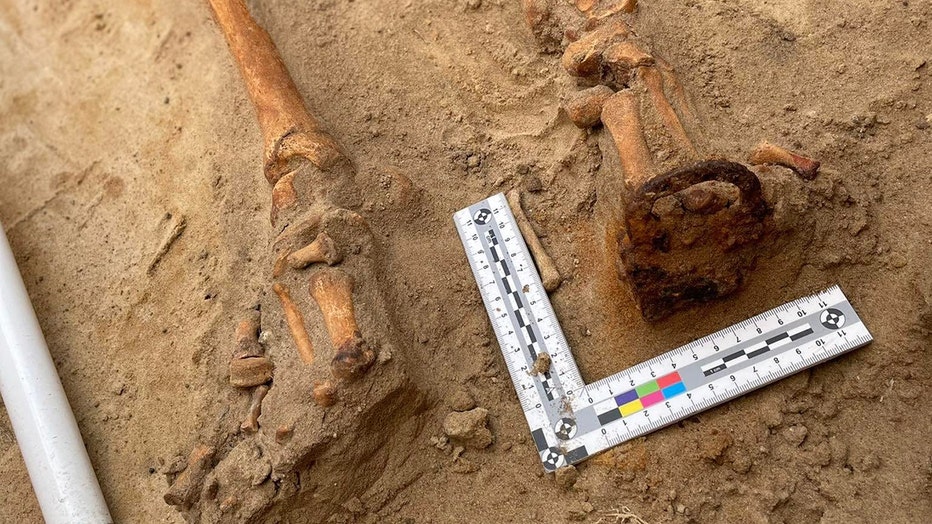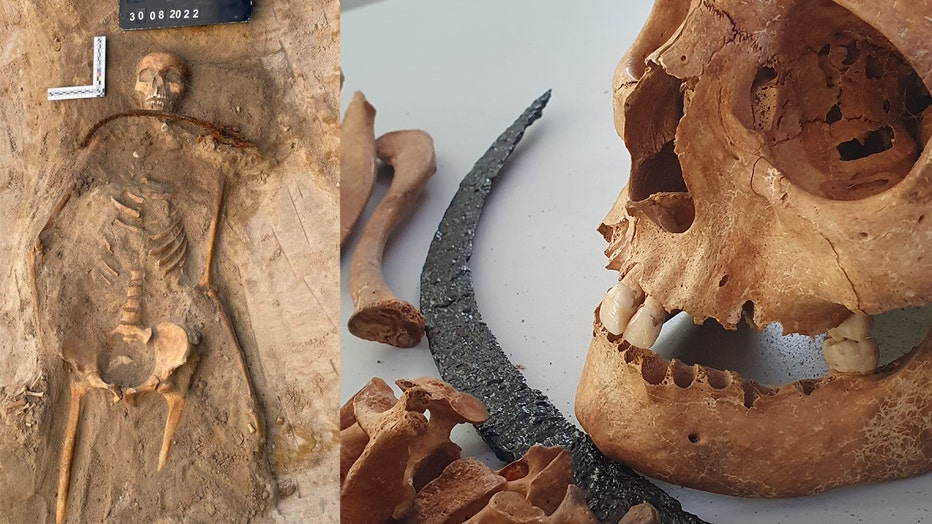Scientists reconstruct face of 17th century ‘vampire’ buried with sickle across neck, padlock on foot
The skeleton is pictured with a sickle at the burial site in Pień, Poland, discovered in 2022. (Credit: Projekt-Pień-TSE Ewolucja)
Two years ago, a young woman's skeleton was found by archaeologists in Poland with an iron sickle across her neck and a padlock on her toe – likely "anti-vampire practices" that researchers said may have been used to keep her from rising from the grave.
The discovery was made in the village of Pień, where archaeologists have found other unusual burials. The woman, who was later nicknamed Zosia, was buried sometime in the 17th century. She was between the ages of 17 and 21 when she died, according to researchers from Nicolaus Copernicus University who made the discovery.
The team later worked with sculptor and archaeologist Oscar D. Nilsson in Sweden to reconstruct Zosia’s face using a 3D-printed replica of the skull and clay, which was revealed this fall.

A reconstruction of Zosia's face is pictured. (Credit: Oscar Nilsson www.odnilsson.com)
"Seeing the remains of Zosia with my own eyes was emotional, it's such a sad story," Nilsson wrote in a Facebook post on Nov. 1. "It led me to the insight that Zosia must be depicted as a human being, and not as the monster she was buried as."
Zosia had a "roundish" facial shape, and the distance between her nose and mouth was long, Nilsson said. She also had a smooth vertical forehead over wide-set eyesockets. Her skin color was decided by DNA and isotopic analyses, possibly pointing toward southern Sweden, he added.
"An interesting face. No vampire. Just a young woman, possibly from a wealthy family but clearly marked by her diseases," Nilsson wrote.
What happened to Zosia?
In history, people suspected of having supernatural powers were often buried in a specific way, such as with their faces down, tied with ropes in the fetal position, decapitated, pressed to the ground with a rock, or with their chests stabbed, according to the NCU researchers.
When members of a given community were suspicious of a person, they sometimes opened the grave and added such "anti-vampire artifacts," such as the sickle and padlock found in Zosia’s unmarked grave.

A padlock was found on the skeleton's big toe. (Credit: Projekt-Pień-Ł.Czyżewski-UMK)
Dr. Dariusz Poliński, a professor from the Institute of Archaeology at NCU, noted how the farming tool likely did not seriously harm the woman at the time of her death "since her head was not cut off and the backbone remained in pristine condition."
Upon her discovery, the media soon dubbed the skeleton a "vampire," and while catchy, Poliński said it’s not exactly accurate.
"Our discovery does not necessarily indicate that a vampire was buried at that site," Poliński explained. "I would prefer to consider these practices as anti-vampire procedures. The woman could possibly have some physical impairment or mental disorder and was thus mistreated by her neighbors who thought she would scare them after death."

The skeleton is pictured at the burial site, alongside a close-up image of the skull and the sickle. (Credit: Projekt-Pień/Ł.Czyżewski/UMK & Projekt-Pień/ Oscar Nilsson)
The researchers pushed back on the idea that the woman was a victim of some type of execution or punishment – such as witchcraft – because she "was buried with care, probably in a coffin, although no remains of wood were found in the excavation site."
"Still, a visible contour of a pillow underlying her head was observed, which can suggest a high social status of a family she was born in," the team said in a press release.
She was buried with her head covered with a bonnet, probably made of silk, because remains of this material were found in the site, the team said. The bonnet was decorated with a silver or golden weft.
The research team said no other tampering in Zosia’s grave was visible.
"The scientists also noticed mysterious greenish spots on her palate which could indicate contact with an object made of copper or copper alloy," the team said in a press release about the 2022 discovery. "Had it been a coin, it could have been placed as the third means of protection against her return to the world of the living."
One detail that drew the archeologists' attention was the fact that the girl's left arm was not placed along her body, but turned left – which the team called a "mystery" still to solve.
Other ‘anti-vampire’ burials
The discovery of Zosia’s skeleton in Pień is among more than 60 burials found at the site from the 17th century. Two children and one teenager found in Pień were buried with coins in their mouth, the team said, while some burial sites contained stones arranged in shapes.
Throughout the 17th and 18th century, many unusual burial practices occurred in Poland in response to a reported outbreak of "vampires," researchers say.
Most recently, archaeologists about 200 miles away in Chelm, Poland, found the remains of a child that had been decapitated.
"The burial clearly shows signs of anti-vampire practices, which were aimed at stopping the dead from rising again," Dr. Stanisław Gołub, an archaeologist with the Lublin Voivodeship Conservator of Monuments who led the excavation, said in September.

